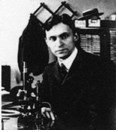Linking Diabetes to Damage to the Islets of Langerhans in the Pancreas

Opie, Eugene
Courtesy of Johns Hopkins University School of Medicine
At the turn of the twentieth century the pathogenesis of diabetes was not well understood. Researchers knew that removing or completely destroying the pancreas produced diabetes in experimental animals, and that the pancreas had an important influence on carbohydrate metabolism. Yet, as Eugene L. Opie (1873-1971) wrote in 1901, "The great amount of experimental and clinical study which has been devoted to glycosuria and diabetes has brought forth few hypotheses which are not still disputed."
Opie made an important discovery that set other researchers on the course to understanding how diabetes develops. As a medical student—he was a member of the first graduating class of the Johns Hopkins Medical School—Opie trained in experimental pathology and began pioneering research on diseases of the pancreas. Investigating organs removed at autopsy from people who had suffered from diabetes and who had pancreatic disease, he found lesions in the islets of Langerhans. This provided convincing evidence that the islets of Langerhans were the source of a so-called internal secretion—a hormone—that was the link between diabetes and carbohydrate metabolism. More than 20 years later, this hormone was discovered to be "isletin," later named insulin.

Drawing of the island of Langehans cells of which are partly transformed into hyaline material. From Opie, E. Disease of the pancreas, 1903
Eugene L. Opie received the AB from Johns Hopkins University (1893) and the MD from Johns Hopkins Medical School (1897). He remained at Hopkins, becoming fellow, assistant, and instructor in bacteriology under WIlliam H. Welch. He became the first scientist recruited to the the newly founded Rockefeller Institute for Medical Research (now Rockefeller University) in 1904, the year the Institute opened temporary laboratories. (The Institute's first permanent building, Founder's Hall, opened on Rockefeller's present-day campus in 1906.) Opie already had received a research grant from the Institute. Opie was a member of the Institute (full professor) until 1910. That year he moved to the Washington University School of Medicine in St. Louis. During World War I he served as an officer in the Army medical corps. Opie became director of the Henry Phipps Institute at the University of Pennsylvania in 1923. In 1931 he became professor of pathology at Cornell University Medical College and pathologist of New York Hospital. After retiring from Cornell in 1941, he joined Rockefeller as a guest investigator and worked in his laboratory there for nearly 30 years.
Opie served as president of the American Society for Experimental Pathology (1923), the Society for Experimental Biology (1934), the Harvey Society (1936), the American Association of Pathologists and Bacteriologists (1918), the National Tuberculosis Association (1929), and the American Association of Immunologists (1929). He was a member of the Board of Scientific Directors of the International Health Division of the Rockefeller Foundation (1934-1938). Among many awards and prizes, his research was recognized with the Trudeau Medal of the National Tuberculosis Association, the Banting Medal of the American Diabetes Association, and the gold medal of the New York Academy of Medicine. Opie was an elected member of the U.S. National Academy of Sciences (1923), and was awarded its Kovalenko Medal (1959).

The original drawing of Wirsung, showing the pancreatic duct. From Opie, E. Disease of the pancreas, 1903
Selected Publications
Opie EL. On the relation of chronic interstitial pancreatitis to the islands of Langerhans and to diabetes mellitus. J Exp Med, 1901, 5: 397-428
http://jem.rupress.org/cgi/reprint/5/4/397
Opie EL. The relation of diabetes mellitus to lesions of the pancreas. Hyaline degeneration of the islands of Langerhans. J Exp Med, 1901, 5: 527-540
http://jem.rupress.org/cgi/reprint/5/5/527
Further Reading
Long ER. Eugene Lindsay Opie (1873-1971): A Biographical Memoir. Washington, DC: National Academy of Sciences, 1975
http://www.nasonline.org/site/PageServer?pagename=MEMOIRS_O
Opie EL. Peripatetic education of a pathologist. Med Clinics North Am, July 1957, pp. 935-952
Rous P. An inquiry into certain aspects of Eugene L. Opie. Arch Pathol, 1942, 34: 1-6
Opie EL. Disease of the Pancreas: Its Cause and Nature, second edition. Philadelphia: JB Lippincott, 1910
http://books.google.com/books?id=ORq0AAAAIAAJ&dq=eugene+opie+disease+of+the+pancreas&printsec=frontcover&source=bl&ots=CEeafw54Uh&sig=ymM0eyeZqzHjHGGHTcakmy12x70&hl=en#v=onepage&q=&f=false
